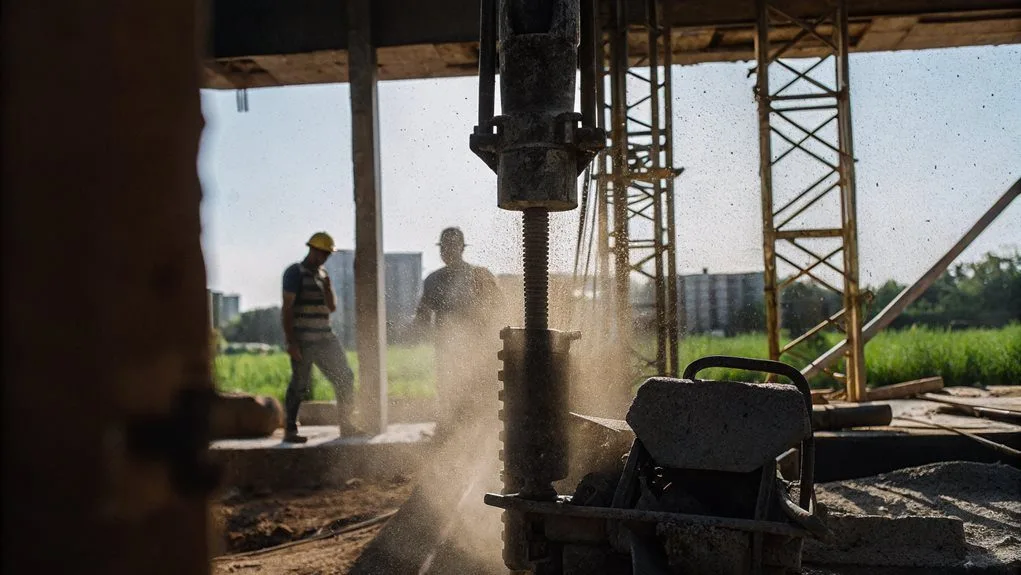You might think air tankers could help with dust control, but you’d be mistaken. They’re built for extinguishing raging fires, not for spraying fine mist to tackle dust clouds. Those big droplets are rather clumsy for that job. Moreover, the costs run sky-high, especially since each retardant drop can hit around R165,000.
If you’re looking for effective solutions, you might want to stick with good old water lorries or creative ground methods. However, there’s more to investigate on this topic and alternative approaches worth considering for dust suppression.
Key Takeaways
- Aerial tankers are designed primarily for fire suppression, using fire retardants rather than fine water sprays for dust control.
- Their lack of spray nozzles and high-pressure pumps makes them ineffective for targeted dust application.
- Large water droplets released from tankers do not adequately address dust clouds, making traditional methods more effective for dust emissions.
- Aerial methods pose high costs and risks that may not justify their use for dust control compared to ground-based techniques.
- Ground crews and watering methods provide reliable and precise dust management while avoiding the limitations inherent in tanker operations.
Understanding the Primary Role of Air Tankers in Fire Suppression
Let’s face it: if you’re picturing firefighters racing in with hoses and buckets, you’re rather missing the point.
Aerial tankers don’t just drop water and hope for the best. No! They’re all about that long-term fire retardant. With real-time reconnaissance and precise tactics, they drop it ahead of the flames, keeping the fire from spreading. Extraordinary, isn’t it?
Unlike helicopters that dump water directly on the fire, these aircraft execute a strategic ballet, and they must fly low no higher than 200 feet to make it happen.
You might think it sounds easy, but trust me, there’s serious risk involved.
Last I checked, 37 brave souls have paid the ultimate price in this firefighting effort.
The Limitations of Air Tankers for Dust Control
So, you think air tankers are the magic solution for dust control? Well, you’d be in for a surprise! They’re built for battling blazes, not for spraying fine mist over pesky dust—talk about a misfit! In fact, while moisture application is an effective method for dust suppression, air tankers lack the precise capabilities needed to apply water in targeted areas. Additionally, the effective deployment of water trucks is crucial for reducing dust levels and enhancing site air quality.
Primary Firefighting Function
When you think about air tankers, it’s easy to imagine massive planes swooping in to save the day during a veld fire, right?
But here’s the thing: they’ve got a primary job and it’s not exactly dust control.
Yup, they’re all about dropping fire retardants—those magical chemicals that help slow down flames. You know, for the big fires only. Experts are even predicting worsening wildfire situations globally.
Imagine trying to nail a tiny target with a cannon. Not so easy.
And let’s not forget the challenges. Blinding smoke? High winds? It’s like trying to read a menu in a blackout! So whilst tankers play a solid role in fire suppression, considering them for dust control? That’s like using a fire extinguisher to quench your thirst—uh, not so effective! Additionally, extreme fire conditions can prevent effective operation of air tankers, limiting their overall utility.
Ineffective for Dust Control
Despite what you might think, air tankers aren’t the magical solution for dust control.
Sure, they look impressive soaring overhead, but that’s just for show.
They’re built to fight fires, not to sprinkle the ground like you’d want for dust.
Ever tried to suppress dust with a giant bucket? It doesn’t work.
Air tankers lack spray nozzles and high-pressure pumps to make those perfect little droplets.
Plus, their coverage is all wrong—more suited for raging veld fires than pesky dust clouds.
And let’s not forget the costs; you really want to shell out hundreds of thousands of rand for a glorified water balloon fight?
In fact, traditional methods like watering have proven to be much more effective at reducing dust emissions and stabilizing surfaces.
Alternative Methods Available
What if I told you that instead of relying on air tankers, there are much cleverer ways to tackle dust?
Seriously, those big machines release water droplets that are too large to be efficient.
You’d think they’d cover everything, right? Not at all! They’re just not designed for that.
Ever tried using a fire hose for a candle? That’s air tankers for dust. Effective dust management is best achieved with targeted practices, like using source extraction systems that capture dust directly at its origins.
Effectiveness of Fire Retardants Compared to Water
So, you’re thinking about whether fire retardants are actually better than water, huh?
Well, while water’s just a lazy splash that evaporates, retardants stick around on vegetation like that one friend who never leaves the party.
They might even help control a fire longer, but are you ready to deal with the environmental headache afterward?
Retardant Adherence to Vegetation
How well does fire retardant actually stick to vegetation? Well, let’s just say it’s not winning any awards for sticking power. With about 85% water and some fancy thickeners, it needs to adhere pretty well to be effective.
When they spray it, they’re banking on bright red colouring to show where it lands—because who doesn’t love a little colour-coded chaos? It coats trees and plants like a clingy ex, helping insulate against flames.
But surprise! It’s not just a fire-fighting superstar; it also doubles as plant food post-fire. Who knew? Just be careful where they drop it; wildlife won’t thank you later.
Viscosity and Effectiveness Differences
Regarding fire retardants, viscosity is the name of the game. You wouldn’t want a gooey mess in a fire, right?
Different viscosities can adjust to tricky terrains, sticking better when you need it most. Gum-thickened options are the superheroes here, optimising their effectiveness in various conditions.
Imagine trying to water a garden with a firehose; you’d probably end up splashing everywhere. That’s where retardants shine, providing more control than plain water.
True, they can cost a bit—around R18 per litre versus free water—but think of the long-term benefits, like preventing re-ignition. Plus, they can cut fire spread in half compared to water.
Fire Control Duration Enhancement
Regarding fire control duration, you want to get it right—fast.
You see, phosphate-based retardants aren’t just fancy liquids; they actually outshine water in the long run. They leave a non-flammable residue, meaning the fire’s less likely to come back and ruin your day.
Sure, you might think, “Water’s cheaper and easier to grab.” That’s all well and good until you’re staring at flames that just won’t quit. It’s a bit frustrating, isn’t it?
While you can scoop water like it’s a free buffet, those tend to fizzle out faster.
Diverse Aircraft Capabilities for Firefighting
When you think about firefighting aircraft, you probably imagine something out of an action movie, right? Well, let’s reel it back a bit.
You’ve got Single Engine Airtankers for those sneaky little fires.
Then there are Large Airtankers, slinging 15,000 litres like it’s no big deal.
Oh, and the Very Large Airtankers? Yeah, they can dump 90,000 litres—talk about hydration!
Very Large Airtankers can unleash a whopping 90,000 litres—now that’s some serious water power!
Water scoopers are like swift little ninjas stealing water from lakes, whilst helicopters get into the nooks where bigger planes fear to tread.
Sure, they’ve all got some impressive tech—night vision and GPS, oh my!
But remember, size matters. Bigger planes can’t just land anywhere.
Cost-Effectiveness of Aerial Firefighting Operations
How can something so essential feel so costly?
Aerial firefighting isn’t just a “sky’s the limit” operation; it’ll set you back over R110,000 per hour, which makes your morning coffee look like pocket change.
Each drop of retardant can cost around R165,000.
You’d think it grows on trees!
Sure, you save a bit with water scoopers, but at R51 million per year, that’s still a hefty price tag.
And let’s not forget the U.S. Forest Service dumps over R9.2 billion annually into these aerial escapades.
They’re effective—when conditions cooperate—but are they worth the cash?
You could use that money for something less risky, like, I don’t know, a flashy car?
Future Research Directions for Aerial Firefighting Techniques
Aerial firefighting isn’t just about throwing money from the sky, right? You probably think it’s as simple as pouring water. Spoiler alert: it’s not!
The future’s looking brilliant, with AI and drones shaking things up. Imagine autonomous aircraft swooping in, making you feel like you’re in a sci-fi film.
The future of firefighting is here, with AI and drones transforming the landscape into something straight out of a sci-fi adventure!
And then there are the tethered drones lifting heavy payloads, because why not? There’s also buzz around eco-suppression systems minimising our mess whilst fighting fires.
But here’s the kicker: we need to figure out how to get these tech marvels working seamlessly with ground teams. It’s like trying to coordinate a dance when everyone’s on a different beat. But hey, at least we’re trying, right?
Conclusion
So, can tankers tackle both fire and dust? Well, not really. They’re great for dousing flames, but regarding dust, you might as well use a garden hose. Sure, they drop water like it’s hot, but that won’t magically clear your driveway. It’s like using a sledgehammer to crack a nut. While we dream of dual-purpose aircraft, reality bites. Let’s leave the dust to the broom and keep the tankers flying high.






